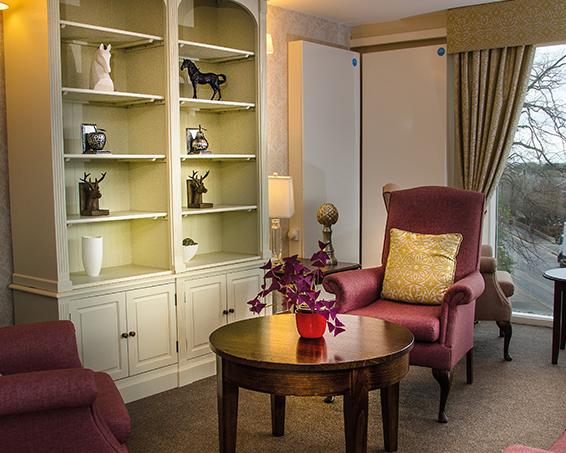6 Ways to Make a Care Home More Homely

The transition to a care home but being able to make your space homely and personalised makes the adjustment smoother. You can help your family member make their space feel more like home by adding personal touches and familiar items that reflect their personalities.
Moving into a care home or a residential home is a huge life change, and residents often feel uneasy about the change, particularly when leaving behind a beloved home. For many new residents, the process of settling in is deeply tied to their environment. Fortunately, with a few thoughtful adjustments, a care home room can become a sanctuary that feels familiar and comforting. Here are some of the things we’ve found that help to make a care home room feel more homely, turning it from a generic room into one brimming with warmth and memories.
Bring Familiar Furniture and Décor
One of the easiest ways to make a care home room feel more homely is by bringing in familiar furniture from the resident’s previous home. Many care homes allow residents to personalise their rooms with small pieces of furniture like a favourite armchair, side table, or chest of drawers. These familiar items provide comfort and create a sense of continuity between the old home and the new living environment. Some care homes even permit residents to bring their own furniture, making the space feel truly personal.
Beyond furniture, décor in a nursing home is equally important in creating a comforting space. Adding personal items such as lamps, rugs, or paintings can make a significant difference. Soft furnishings like cushions and throws can also add a touch of home. These details transform a room, turning it from a blank slate into an environment that reflects the resident’s particular taste. Family members can help by bringing sentimental pieces that remind the resident of happy memories, such as heirlooms or objects tied to past hobbies.
Display Photographs and Mementos
Photographs of family, friends, and meaningful life events can make a room feel instantly more personal. Displaying these photos around the room helps create a visual story of the resident’s life, offering comfort and a sense of identity. Family members can help create a small gallery wall or place frames on shelves and tables, ensuring that loved ones’ faces are always nearby.
Adding a collection of mementos, such as souvenirs from travels or small trinkets with sentimental value, can make a room feel cosier. Each item tells a part of the resident’s story, bringing an air of familiarity and offering talking points for both care home staff and visitors. Getting to know other residents can also help new occupants feel more comfortable and integrated into the community. These items are not just decorations—they’re bridges to fond memories and reminders of past achievements.


Incorporate Favourite Colours
Colours play a significant role in how a space feels, affecting mood and overall comfort. If possible, residents could incorporate their favourite colours into the room, whether through bedding, cushions, curtains, or wall decorations. This can create a sense of familiarity, especially if the colours match those from the resident’s previous home.
Most care homes encourage you to bring items like throws, blankets, and pillows can soften the room’s look and feel, making it more inviting. A familiar blanket draped over the bed or a well-worn cushion placed on a chair can provide a sense of continuity and security.
Bring Personal Items from Home
Moving to a care home doesn’t mean leaving behind all personal belongings. People coming into residential care are encouraged to bring personal items such as books, keepsakes, and everyday accessories that have been a part of their lives for years. Whether it’s a well-loved book collection, a treasured clock, or a houseplant or two, these objects help create a familiar environment and give residents a sense of ownership over their new space.
For those with a hobby, bringing related items into a care home can help them continue their activities in the new setting. Whether it’s knitting needles or sports memorabilia, having access to these items can be incredibly comforting and help maintain a sense of independence and identity.
Create a Memory Box
Memory boxes are a powerful tool for personalising a care home room, especially for residents who are adjusting to new routines or experiencing memory challenges. A memory box can be filled with photos, letters, small tokens, and other items that evoke cherished memories. These boxes allow residents to hold onto tangible reminders of their personal history and can be good conversation starters with new friends.
Creating a memory box can also be a collaborative activity involving family and friends. Filling it with carefully selected items offers an opportunity for bonding, and revisiting the items over time can help the resident reconnect with their past and feel a stronger sense of self.
Use Familiar Scents and Sounds
Familiar smells can be especially comforting when someone moves into a care home, as scent is closely tied to memory. Bringing in scented candles, air fresheners, or essential oils in fragrances that the resident enjoys—like lavender, vanilla, or fresh flowers—can evoke feelings of nostalgia and relaxation. However, for safety reasons, many care homes may not allow open flames, so plug-in diffusers or scented sachets are good alternatives.
Music is another sensory element that can make a care home room feel more homely. A small radio or portable speaker can provide a comforting backdrop of familiar music or calming sounds. Whether it’s classical music, favourite oldies, or nature sounds, having access to familiar background noise can bring a sense of familiarity.
Feel at Home at Deeside Care Home
Making a care home room feel more like home is essential for fostering comfort, familiarity, and a sense of belonging. Simple personal touches, like family photos, favourite furniture, and cherished mementos, can go a long way in creating a warm and inviting space that resonates with the resident's life story. At Deeside Care Home in Aberdeen, we are committed to helping our residents create environments that reflect their unique personalities and histories. Contact us today to learn more about how we support our residents in making their new home truly their own.





